Clay sealing with double axes carried in procession
Σ-Τ592
Clay
Almost intact, with clear image
Length: 2 cm. Width: 1.80 cm.
Hagia Triada
Royal Villa, sealing archive
Late Bronze Age, Neopalatial period, Late Minoan IB period:
1500-1450 BC:
Gallery:
VIIICase:
77Exhibition thematic unit:
Late Bronze Age - Neopalatial period (1700-1450 BC). Minoan religion. Palace cultCult scenes
Description
Clay sealing with two figures, probably a woman and a man, in procession to the left holding double axes. The woman, in front, is wearing a richly pleated skirt with a belt and carrying the axe comfortably supported on her shoulder, turning her head backwards towards the man following her. The man is wearing a long, wide hide loincloth and raising the axe just above his head, arms in front of his chest. There appears to be a long ribbon hanging from the axe handle. The double axe, the most important sacred symbol of the Minoan religion, is often depicted in Minoan seal-carving being carried in procession during religious ceremonies. Similar large double axes have been found at the Villa of Nirou and the palace of Zakros, proving that that they were actually used as sacred emblems and confirming that the scenes in the iconography depict real ceremonial events.Bibliography:
D. Levi, "Le cretule di Haghia Triada", Annuario della Scuola archeologica di Atene 8-9 (1925-26), 131, fig. 140. N. Marinatos, Minoan Religion. Ritual, Image and Symbol, Columbia 1993, 136, fig. 105. Corpus der minoischen und mykenischen Siegel II6, 10.Author:
S. M.Photographs' metadata
